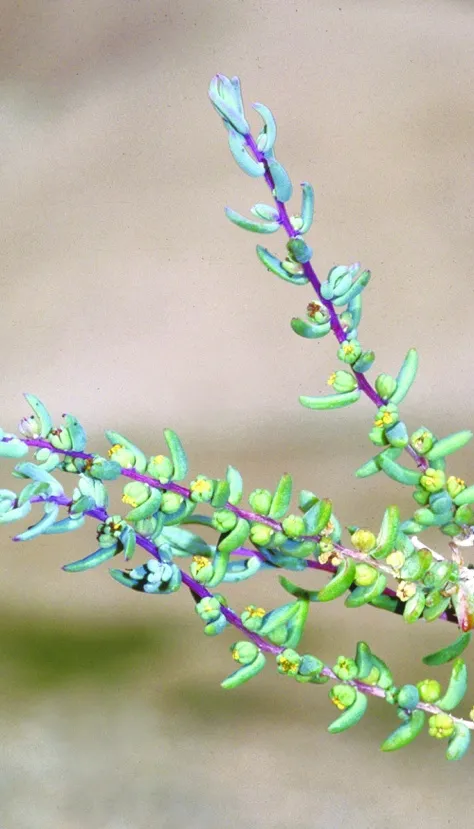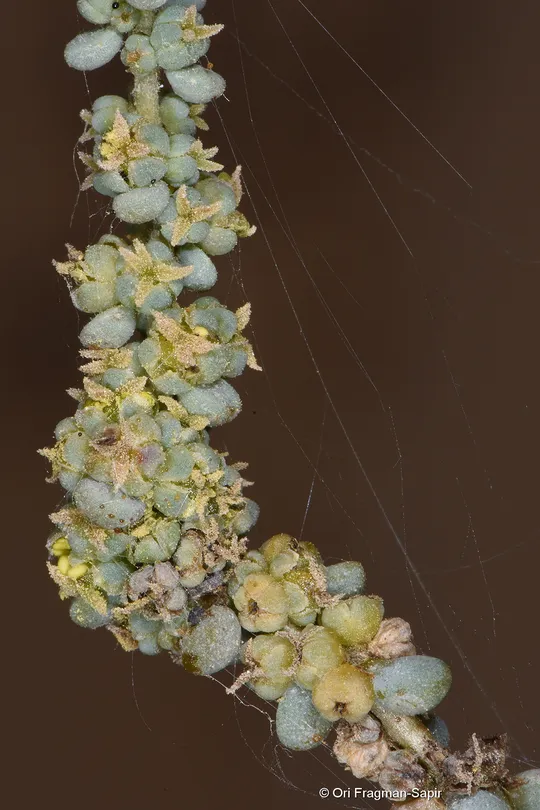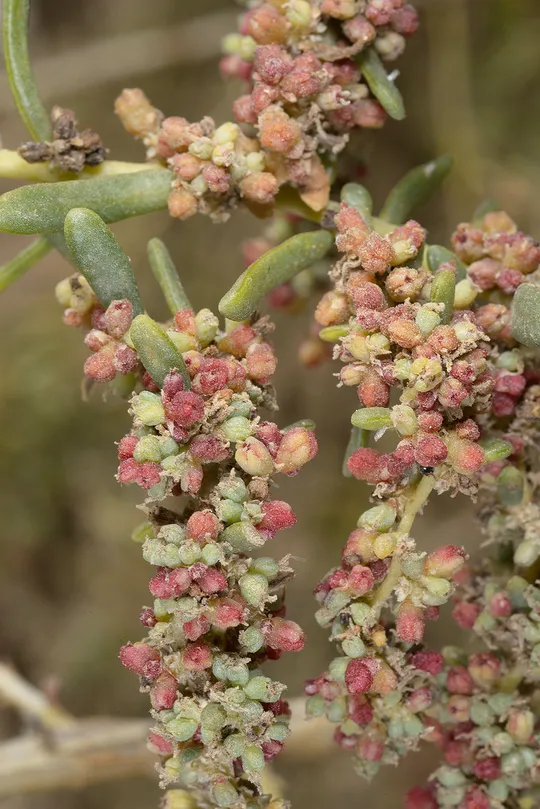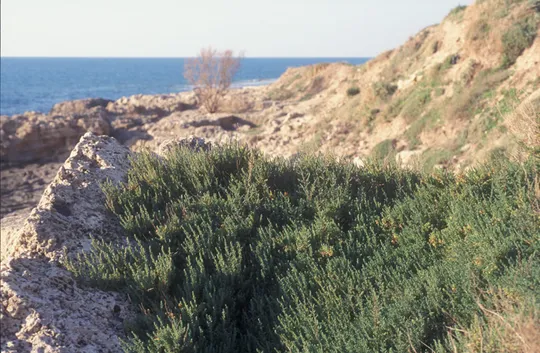Palestine Seablite
Suaeda palaestina

Suaeda palaestina is a low dense shrub that belongs to the Chenopodiaceae plant family, which was first described from the Kaliya salines. It is endemic to Israel and its surroundings (Jordan and Sinai). It is 20-60 cm high and has succulent leaves that look like small curved sausages. Leaf color is usually reddish purple (in stress conditions) or dark green and its cross-section is round and not flat. The flowers are scattered among the upper leaves not concentrated at the ends of branches (as found in S. fruticosa). S. palaestina flowers in spring and summer, but considerable parts of the populations do not flower at all in some years.
Grows in southern Israel and in the Jordan Valley. In the Jordan Valley – from Ǧiftlik south to the northern shore of the Dead Sea, where the largest population is located and from where the species was first described. On the shores of the Dead Sea and in the Judean Desert it is very rare (Mazin Ruins) and usually grows alone. Zohary (1980), who first described the species, recorded it from the Sodom salt marshes, the mouth of Wadi Zohar and Kalya, which is the only site where it still grows. All current efforts to find the species at the other locations failed. In the Negev, it grows on steep chalk outcrops in the Negev Highlands and the southern Negev, where it is very rare, but when found, is dominant in patches.
In the central Jordan Valley salt marshes (Wadi Malaha Swamp, the Al Akhmar salt marsh and the Uǧa salt marshes) there is a large population of Suaeda that is similar to Suaeda palaestina, but is different from the typical form of this species. The plants grow in dense spherical shrubby clumps reaching a height of 60-1000 cm, a phenomenon unknown from other sites. Most of the leaves are pointed, a characteristic of Suaeda vera. This could possibly be a transitional population between S. vera and S. palaestina.
Salt marshes on Lisan marls in the Jordan Valley and on exposed chalk slopes in the desert .Commonly found with Seidlitzia rosmarinus in gypsum rich marls between En Hogla and the Kalya shore on the Dead Sea.
The genus Suaeda has 110 species throughout the world that grow in salt marshes, along coasts and in deserts. All the species have succulent sausage-shaped leaves. Eight species grow in Israel (an additional species, Suaeda hortensis is episodic), two of them are annual and the remaining six are shrubs. The species similar to S. palaestina are S. vera and S. vermiculata. The latter has short thick lens shaped leaves, sometimes spherical in shape, while in S. vera some of the leaves have a flat cross-section. In stress conditions, the leaves of all the species take on a reddish-purple hue and are hard to tell apart. Suaeda vermiculata is found only in the Aravah and S. vera appears in coastal salt marshes but can also be found in the Jordan Valley salt marshes (Malaha Reserve), En Ovdat and in Ktsiot. It is very difficult to distinguish the species in the field, and many records are probably incorrect. This is also true of herbarium specimens that may be mistakenly identified.
• The conversions of salt marshes in the lower Jordan Valley areas to agriculture lead to habitat loss and to the extinction of populations. Recently many rich populations were destroyed, due to Palestinian development in the area of the Jericho Botanical Garden and following the relocation of the settlement of Bet Ha'Arava. Kibbutz Kalya has also expanded its agricultural areas towards the Kalya Junction, at the exact point from where the species was first described.
• The distance from the Jericho plains and Uǧa to the Kalya area is not great and apparently there is an exchange of genes between populations. However, the Negev and Judean Desert populations are sparse and far apart.
• Outside Israel the species grows only in Sinai (very rare) and in Jordan (Danin, 2004), where it is also very rare and possibly threatened.
• The species is protected only in the Malaha marshes and in Wadi El Akhmar, but the populations there are small compared to those in the Kalya Junction and Jericho Plains.
Its habitat is being rapidly destroyed as a result of development by the local population in eastern Jericho, Kalya, Bet Ha'Arava and the Jericho bypass road. Three sites for preservation should be chosen in this area, where Suaeda palaestina originates, for demographic monitoring. Priority should be given to the Kalya Junction, where agriculture and the Regional Council structure have destroyed a major part of the salt marsh. An attempt should be made to rehabilitate the area east of the road, where there remain areas of S. palaestina natural habitat.
: Endemic to Israel, Sinai and Jordan. The record from Jordan is based on Danin (2004). The species is mentioned in the literature from southern Iraq and from the east coast of Crete. This data, however, is doubtful due to the difficulty of defining this species and distinguishing it from S. Vera that grows on the Mediterranean coast.
A sub-endemic species described from the Jericho Plain. Grows in desert salt marshes. Endemic to the Rift Valley, the Negev, Sinai and Moab, but most of the populations grow in Israel. Its typical habitats, arid depressions and salt marshes in the Lisan marls from Jericho to the Ǧiftlik, are being destroyed due to development in the region. It is vitally important to allocate a reserve for its preservation before the habitat becomes extinct. Its importance for conservation is primarily due to its status as a sub-endemic species, most of whose populations are limited to Israel.
Eig,A. 1945, Palaestine Jour. Botany, Jerusalem series,3,126.
Current Occupancy Map
| 1000 squre meter pixel | 5000 squre meter pixel | 10000 squre meter pixel | |
|---|---|---|---|
| number of observations | 0 | 0 | 0 |
| in total pixels | 0 | 0 | 0 |
| Family | Chenopodiaceae |
| Classification | On the endangered species list |
| Ecosystem | Desert |
| Chorotype | Saharo-Arab |
| Conservation Site | Kalya junction (the first species described from there!) |
| Rarity |
1
2
6
|
|---|---|
| Vulnerability |
0
3
4
|
| Attractiveness |
0
0
4
|
| Endemism |
0
3
4
|
| Red number |
1
4.2
10
|
| Peripherality | 0 |
| IUCN category | DD EW EX LC CR EN VU NT |
| Threat Definition according to the red book | Endangered |
 Based on:
Based on:






